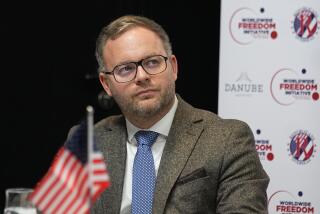Hungary Youth Trying to Get Over the Big Lie
- Share via
BUDAPEST, Hungary — Joszef Bodor, 24, was lounging Friday morning on the edge of Heroes Square, predicting a bleak future for himself and all of Hungary, when a voice over the loudspeakers asked the crowd to observe a moment of silence to honor the memory of those killed in the 1956 revolution.
Bodor stopped in mid-syllable. He straightened his shoulders and flung away the cigarette that dangled from his lips.
“I don’t know what will happen tomorrow in Hungary or the day after tomorrow,” the unemployed youth confessed moments later, as the speeches resumed lauding Imre Nagy, whose attempts as premier to change Hungary lasted 13 days in 1956. “But this is important, and it’s important for me to be here and show that the people are united.”
The same mixture of pride and uncertainty echoes widely among Hungarian youth today, as they wrestle with how to plan for the future amid a past that changes with each new revelation in the daily press.
Implanting Skepticism
Theirs is a generation taught public lies at school, private truths at home and weary of the mental calisthenics needed to balance the two. For some, the struggle has taken its toll, producing adults who find it difficult to believe in anything.
“The reason my generation has so many troubles with schools and with jobs is because we had to live a lie and in the end you don’t know the truth,” said Erzsebet Toth, as she stood in line with 50 other villagers from Gyula, a town near the Romanian border, to lay flowers on Nagy’s tomb.
But Toth, who is 37, says she rarely discusses politics with her 8-year-old son.
“Life here is changing so much and everyone must work 12 to 13 hours a day. You have no time for talking,” she said.
For Gabor Fodor though, talking and remembering are the only way to insure that 1956 doesn’t happen again.
“The people who destroyed this society and killed many of its members are still in power. We don’t want revenge and retaliation, but we don’t want to forget,” said Fodor, one of the leaders of the Young Democratic Organization, one of the new political organizations that have sprung up since the government announced that it would move towards a multi-party system.
Unhelpful Books
They certainly can’t turn to the history books for help. The current texts date from the pre- glasnost 1970s. They still brand Nagy as a political traitor and the 1956 revolt he led as an ill-conceived “counterrevolution.”
Late last year, when the party decided to re-evaluate the events of 1956, it commissioned new history books. But Nagy’s political rehabilitation occurred so quickly that those texts too, will be obsolete when they reach the classrooms in September. Government officials say pupils can expect texts reflecting today’s events some time in the early 1990s.
For now, students must play it by ear.
This year, for example, a student would get top marks in a history exam for identifying Nagy as a progressive Communist leader who was wrongly executed for trying to lead Hungary away from a Stalinist personality cult.
“Last year in Hungary, it would have been the wrong answer,” said teacher Lajosne Haszar of Pesti Barnabas High School. “But then last year, the student wouldn’t have been asked about this topic.”
Teachers, who must also adjust to the glasnost era in Hungary, “are in a very difficult position, not only because of the out-of-date texts but because they have to face the fact that the way they’ve been teaching history was untrue,” said Imre Knausz, who heads the history department at the National Institute of Education.
Today, the more cautious teachers lecture on the chronology of events without drawing conclusions.
“I teach that there is no correct answer yet about 1956 because it’s still an open issue, and we don’t know all the facts,” said Imrene Ferencsik, who also lectures in class that Josef Stalin’s accomplishments outweighed his faults.
The more liberal teachers discuss articles in the daily papers, and those who lived through 1956 draw on those experiences.
Haszar said that she has been haunted for more than 30 years by the sound of Nagy’s voice on the radio, pleading “Please save our souls,” from the Yugoslav Embassy where he had taken refuge. The memory has given her courage to teach more openly, she said.
Some students said teachers told them to throw away their history books after the class reached 1945. Twenty-three-year-old Judit Hegedus said her teachers simply omitted 1956 from the curriculum.
Hegedus, the daughter of a former writer of samizdat --underground publications--said before Nagy’s reburial that attending the ceremony was both an honor and a duty.
“I hope it is a huge crowd, so we can show to the world that Nagy was a great leader and not, as has been said in the past, an enemy of the people.”
But such arguments didn’t sway 19-year-old Dora Papp.
“Politics don’t interest me,” she said, heading off to her teller’s job at Budapest Bank on Friday morning as thousands of others poured out of the subways and into Heroes Square. “With all these reforms . . . we, the young, still don’t know the truth.”
Which is exactly why a 28-year-old couple called Dory, whose parents had fled Hungary after the revolution, made the pilgrimage back from West Germany this weekend with their 10-month-old son, Koppany.
“This is the first step toward rehabilitating the heroes of 1956,” Csaba Dory said, holding his son up to view the crowd.
The child gurgled and waved his arms, playing with a green, red and white Hungarian flag pinned to his jumpsuit.
“When he grows up, he can say, ‘Well, I was there for the beginning of democracy.’ ”
More to Read
Sign up for Essential California
The most important California stories and recommendations in your inbox every morning.
You may occasionally receive promotional content from the Los Angeles Times.










